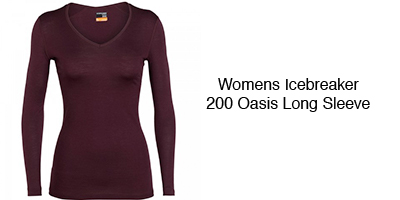Layering your clothing is a useful technique that is designed to help you get the most out of your outdoor experience. By giving you flexibility in your wardrobe to accommodate inevitable weather changes, layering will keep you comfortable in temperatures that may otherwise send you back indoors. There are three key components to a proper laying system: Base layer, mid layer and outer layers. These layers often come in various “weights” and are generally classified using the terms light, medium or heavy. The weight of the layer correlates to warmth, so the weight you choose should match the activity and energy you are exuding.
- Base Layer – Moisture Control
The base layer is the first layer in a proper layering system that sits closest to the skin. The main purpose of the base layer is to wick away moisture, dispersing sweat throughout the rest of the garment so it can evaporate quickly. Base layers can be manufactured in many fabrics, the most popular being merino wool, polyester/synthetic and silk. Merino wool is known for having a soft hand, quick-drying fibers, and natural odor-resistant properties. Synthetic fiber base layers are often more affordable and easier to care for, but they can retain body odors over time. Silk is often the lightest weight option and most appropriate for light physical activity. With all the fabric options out there, it is important to remember that cotton is not your friend when layering. It will hold on to moisture, often making garments heavier, and cotton garments will take longer to dry.


- Mid Layer – Insulation
The mid layer is all about insulation, allowing you to retain body heat and stay warm. As with base layers, mid layers are produced in many fabrics. Fleece, down, or synthetic filled pieces are all popular mid layers. Fleece is a great option for additional moisture management and breathability. Traditional down provides the most warmth-to-weight ratio and it keeps its lofting capabilities when compressed; however, it loses its warmth properties when wet. Hydrophobic down has been treated with a water-repellent chemical that allows the down to stay lofted when wet; it is not as widely used at this time, but many consider this technology a game changer. Synthetic fiber is durable and will often dry faster than down. It also holds onto its warmth properties more successfully than down when wet, although synthetic can be bulkier compared to its downcounterpart.


- Outer Layer – Water & Wind
The outer layer is arguably the most important in the layering system. It is designed to keep all other layers dry and needed to keep the wind out, which allows every layer to perform their roles most efficiently – thus keeping you warm. For most activities, the perfect outer layer should be waterproof, windproof, and breathable. Almost all will have some sort of DWR (durable water repellent) treatment, which allows water to bead up and roll off the surface of the garment, preventing it from soaking through the top layer. When trying on an outer layer, it is recommended that you wear all of your intended layers underneath, ensuring you have enough room for movement. It is not uncommon to size up in an outer layer to prevent the feeling of constriction.

 One final component to consider for your outdoor clothing arsenal is the “accessories.” By having a hat, gloves, and socks on hand, you can increase your warmth and protect your extremities from the elements.For more information on how to layer and to get personal recommendations, come visit the Summit Hut!
One final component to consider for your outdoor clothing arsenal is the “accessories.” By having a hat, gloves, and socks on hand, you can increase your warmth and protect your extremities from the elements.For more information on how to layer and to get personal recommendations, come visit the Summit Hut!